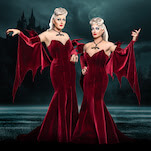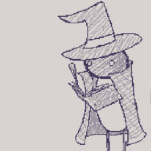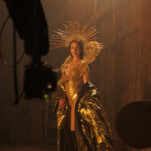But my concern was what makes viable, intelligent, very educated people seek to engage in that kind of organization or group. It was the probing of my own brain as much as anything, but I did as much reading as I could do about it. And I guess the conclusion that I came to personally—although I should preface this by saying whatever anybody else wants to think of any of these aspects, they’re perfectly welcome to. [Laughs.] I’m one of those who considers reading a 50-50 proposition; I do my part, and then the reader does their part. No two people seem to read the same book, and that’s fine.
KD: Well, the Binewski family is in and of itself a cult, of course. It has many of the same structural functions as a cult. It begins, at least, with the patriarchal head and his henchwoman partner, his wife, and the headship switches over time. So they’re brought up in this structure which is divorced from the rest of the world, an isolated subset identified as the “we,” as opposed to all the other “theys.” Freedom within any kind of social structure—the whole issue of exactly what the human animal is—is an ongoing preoccupation of mine. And I certainly don’t think I’ve come to the end of that exploration, and with any luck, I never will. But I’m very curious about exactly what kind of beast we are. We’re so complicated.
In a funny way, I do have myself a kind of loner aesthetic, which I consider to have been bred by Captain America and Superman comic books when I was a child. So there really isn’t a pack, there isn’t a social structure, around this American concept of the loner, the people who pull themselves up by their own bootstraps and go their own way, kind of Ayn Rand-ish, a monomaniac, I suppose. But within a social structure, a familial structure, or a cultural structure of various kinds, there is a substitute for actual freedom. I mean, actual freedom is a very abstract notion; we have no idea what it means, except within a context—freedom to do what? So within these social structures, freedom becomes defined as power, your ability to make choices, and the power relationship within a family, any family. And within the Binewski family are shifting commodities that depend on various things. And the power within the larger carnival itself shifts also. The book is a fable, of course. It’s not meant to be realistic, of course. But nonetheless, I suppose I would try to understand these vectors of force at play in human life.
AVC: If we go back to the cult idea, “the ability to do what you want” is one definition of freedom, but a definition you often hear in religious circles is freedom from something. So if you’re in a cult situation, they might promise you, as Arturo promised the Admitted, that they would be free from.
KD: Yes, isolation. “Peace, isolation, purity.”
AVC: And as Miss Lick wanted to give the women freedom from the male gaze.
KD: Well, that was her rationale, anyway.
AVC: There was a lot of discussion about whether we could make sense of her motives in the case of Miranda—to try to get rid of her deformity, but not change her otherwise.
KD: I guess in my mind, the idea was that the tail was just the beginning for Miranda, because Miranda was cursed with other burdens that Miss Lick did not approve of—an attractive face, an attractive body. In my mind, the tail was just the beginning. In Olympia’s mind, the tail was the beginning of the end. The alpha and omega.
AVC: You’ve mentioned in other interviews your experience as part of a magazine crew, selling magazines door-to-door. In terms of ritualism and authority structure, what does that have to do with your fascination that led to the creation of Arturo and his cult?
KD: Well, the magazine crew was actually set up very much like a cult. There was the boss, who was the road manager. And then there were all these nebbishes who were the hirelings, the little people who were trotted around to do the actual door-to-door magazine sales. And each day on the road would begin with the entire crew meeting in the boss’ motel room, where the boss would give a rousing rhetorical sermon on the necessity of doing this, that, and the other for the benefit of the crew, your own benefit, what was bad and what was good. A very clear laying out of a kind of dogma. And the disciples were required to recite in various ways, and to practice, rehearse, in various ways, in front of the crew and in front of the manager, their spiel—memorize their little spiel that they gave when they went to the door. Which was always a lie—“I’m saving up for a trip to Paris,” or “I’m saving up to go to college,” one line of baloney or another.
I think actually sales groups tend to do this a lot, even ones that are not necessarily fraudulent. The kind of rally-and-cheer meeting is quite common, in which everybody is bolstered and their blood is pumped up. I don’t know if they actually do jumping jacks or anything, but they definitely are given the message of the day. And they’re invested with as much energy as the boss can pump into them, and then they’re sent out to do battle with the great Them, which is all the hapless potential customers, for whom they have absolutely no sympathy or recognition of humanity. It’s definitely a structure in which it’s an absolute of we vs. them. So that was my first personal experience of something that I would identify as a cult. From the time I was little, I’d been kind of freaked out by the whole deal with large groups of people. And even moderate-sized groups of people. It’s always made me very uncomfortable. It’s such a strange phenomenon, what happens to people when they’re all moving in the same direction, all chanting the same tune, the same line of slogans or something. That stuff always seems very alien and bizarre to me, and kind of scary.
My perception of the human animal is as an extremely dangerous predator. That’s who I perceive us to be as a species. Maybe the most dangerous predator on the planet, with the exception of a few microbes. And so I’m really grateful for the degree of socialization that prevents us, most of the time, from killing and eating each other. And I really admire all the social structures that have been designed and layered and niched in that encourage bonding toward a kind of social harmony that is meant to contain and counteract our natural inclinations toward predation, ferocity, and eating whatever moves. Everything from marching bands to synchronized swimming is really marvelously designed, for the purpose of creating this general harmony. So I think that there’s good reason why we have these tendencies to group together, and to take on groupthink of one kind or another. I think there’s a lot of functional stuff going on there for us as a viable species. It’s just that humans, we get carried away. We’re not good at moderation. So there’s always this tendency for things to get a little out of hand. There really was that moment with the magazine sales crew when I found myself, even though my third eye was sitting off in a corner of the room watching this—“My God, what a bunch of idiots”—I was still going along with it, going through the motions. And that really disturbed me.
AVC: It seems as if that absolute line between us and them is the condition for these strange inverted moralities within the groupthink. If you don’t have an opening to some other example of flourishing living, then you can just demonize everything on the outside and see your inside life as the only way to flourish.
KD: We see this in so many different ways. It’s certainly the operative process in all kinds of fundamentalisms. But also simply the communication strategy of war, the communication strategy of rivalries of all kinds, are always to dehumanize the opposition. To reduce them to as simplistic and villainous a structure as possible. One of the things I wanted to avoid—you know, it’s been 20 years since I really looked at this book, so please forgive me, I’m not as detailed about it as I should be—one of the things I specifically wanted to avoid is blanket villainy. I wanted to create bridges between at least some readers and each of the primary characters, so that despicable though their behavior might be at any given moment, there had to be connections made, sufficiently so that if you were willing, if you were open enough, you would see or recognize that this despicable behavior was being committed by a person who was as dimensional and as conflicted and as silly, perhaps, as we the readers are ourselves. I wanted to avoid the ability to blank out the humanity of the villains.
[pagebreak]
AVC: That brings up the point-of-view strategy for the novel. One of the reactions of the readers was, here we have transgressive fiction, because the world of the Fabulon is so hermetically sealed away from the outside. We have Oly, the Bag Man, and Sanderson, and that’s about it as far as narrative points of view. How did you decide on those limits?
KD: The premise required a first-person narrator, because the narrator had to be able to convey the extreme opposite set of standards which were being adopted here. A third-person narrator, I felt, would’ve just been far too distant, and would’ve been constantly conveying some kind of judgment about what was going on. While an insider could completely accept this set of standards, which are not the usual, and embrace them. And in the process of embracing them, while proving herself not altogether reliable, nonetheless demonstrate what those standards meant. And of course it couldn’t be one of the stars of the show, because stardom is its own burden, and has its own set of circumstances. It had to be a side person, who was an observer and perhaps a yearner toward. So Olympia was kind of the chosen, designated specimen for that. In seeking to provide other information, however, I was constantly confronted by my own construct, because there’s only so much that a first-person narrator can observe personally. And so I had to create this idea of her continuing to learn and finding newspaper and magazine articles and collecting them, so that it could contain things that were not simply witnessed by her, but things that she learned later and that she would report in an almost reportage fashion, or that could be reprinted in the manner of Norval Sanderson’s stuff, or some of the newspapers that appear. So trying to fit in those other voices while maintaining the first-person narrative structure was a bit of a challenge.
But I wanted to include the Bag Man’s voice because he was this interloper from afar, and he was a self-made freak. Although I think at some point Olympia declares that freaks are born, not made, nonetheless, there’s a great deal of effort amongst us a species to make ourselves into freaks when we are actually quite ordinary people. So the Bag Man, although he did not intend the effect of what he was doing, was a self-made freak. But it was also important to me that he not be allowed to be completely reviled, not be a one-dimensional villain, and that it be understandable how he could be recruited or allowed to join the family. So his story had to be told.
AVC: The word “exceptionalism” comes to mind in your previous discussion of the rugged, lonely American individual, the person who isn’t subject to the normal rules—we all want to be such a person. We believe ourselves to be exceptions, and that’s why we try to believe ourselves to be special.
KD: Well, you run into all sorts of strange variations on this theme. Again, I’m speaking in the most grotesque generalizations, and I really beg your pardon for that—this is the way I see it, I guess. Humans seem to go through different phases in their lives. When they’re quite young, they assume that they’re the center of the universe, and they’re quite surprised to learn that other people even continue to exist when they leave the room. And then there seems to come on at some phase or other in development, the desire to fit in. They want to be like everybody else. And sometimes people continue on in that way. They don’t want to stand out. They want to be like their pals. They want to be totally accepted.
And sometimes people go off in a slightly different direction of wanting to be different, of wanting to be special, of wanting to be more, and I think that those people are often—not always, but often—genuinely different in some way. Perhaps their gender orientation is not acceptable or popular, not the norm. Perhaps their physical design is literally, in some way, setting them apart. Or perhaps, in many cases, they feel the burden of their ordinariness so dreadfully that they strive to find some way of being unique. I think that can be a very positive thing, but it also can be negative, destructive. It’s often the case where—it’s really quite hilarious; I don’t always like to laugh, but I’m old, so I get to—where the poor little kid with his pink mohawk and his nail through his nose and tattooed armpits and whatnot, he’s expressing himself. He wants to be an individual. The fact of the matter is, he’s doing that because his 10 best buddies are all doing the same damn thing. We run into this all the time. So it’s, you know, humans. My God. [Laughs.] In my next life, I plan to be a more respectable creature. For now, this is what is given to us. So I don’t know—I think we’re all freaks at heart. I think some people strive desperately to be normal, and I think other people strive to be abnormal.
AVC: You give these loving descriptions of performance, in the carnival and in your writing about boxing. Does the concept of performance attract you?
KD: I am fascinated by performance. It does seem to me the performance arts and the performance vocation require a very specific set of skills and talents and a frame of mind that is different, perhaps, than that of a lot of people. Whether it’s brain surgery or flying a jet plane or boxing or ballet dancing or violin concertos or rock ’n’ roll, performers—no matter how many years of practice and study they have committed themselves to, all the preparation in the world does not matter if they cannot make it happen here in this moment, this place. And that is a crisis mentality that is absolutely fascinating. I as a writer have the luxury of sitting around in my pajamas and rewriting until the cows come home.
Of course, there’s always an audience. The brain surgeon has an audience. The jet pilot… Well, he has his own set of difficulties to deal with. In a funny kind of way, there’s always an audience, and one of the things that fascinates me is stage fright. I’m sure we’ve all run into these quickie-cute articles about how people would rather be burnt to death at the stake than talk in front of a group of people. I’m a kind of mechanistic thinker. I’m always trying to figure out “What’s the function of that?” or “Where does that come from, and why do we have that?” So in thinking about this, I’m thinking once again about our fundamental nature as predatory foragers of a very dangerous kind, and of the pack inclination. Basically, we are pack animals. We may be evolving toward hive animals. I think that could be argued. But at least during my lifetime, we have been fundamentally pack animals. And so the nature of the pack is that if all the eyes of the pack are on you, you are either the leader, or you are lunch. So it’s a basically hazardous situation to have the eyes of the pack upon you. And I think that’s really visceral. I think that’s bred in the bone. That’s species-deep. So the successful performer is someone who can convince themselves, as well as the pack, that they are, at least for that brief moment, the leader.
AVC: We could get into a lot of stuff about leadership and authority, because that goes right back around to the danger zone.
KD: Absolutely. Exactly. It’s all connected. [Laughs.] It is, damn it.
AVC: We discussed when we imagined this story took place, what time period, because there’s a timeless quality to these sort of rural road shows. And there aren’t many identifiable pieces of technology or media at all in the story.
KD: No. At one point, Arty does go and use a payphone to hire the frat boys to terrorize Al and Fortunato. I understand that. That was deliberate on my part. In the sense that this is a fable, it is set loose of time. Obviously it’s in kind of latter-day America, because there are motorcycles and cars and stuff, but it could be the ’50s, it could be the ’90s, it could be 2007. The fact that you don’t know is supposed to be liberating rather than frustrating. [Laughs.] Sorry about that.
AVC: I don’t think it frustrated people. It wasn’t until people started talking about it that we realized there was a difference in what people imagined.
KD: I love that. I just love that people can interpret it in so many different ways. Can I ask, did any of your readers find the book funny?
AVC: We had a discussion about that at the very end of our chat. My editor said, “How would we sum this book up? What is it? What genre is it?” And one of the first responses by one of the staffers was, “It’s a black comedy.” And then other people said, “I don’t see it as comic at all. It’s a Greek tragedy.”
KD: Even people who didn’t find it funny but continued to read it anyway? Interesting. It’s always curious to me. I was with this thing for almost 12 years before it went out, and it’s a forest-and-trees proposition. It’s your own private autism. Your little world where you retreat entirely. Anything can happen. So the prospect of these things going out and having adventures with people I’ve never met and never will meet is quite intriguing to me.
AVC: Let me ask you about what you’re doing now—a collection of your writing about boxing.
KD: It’s called One Ring Circus: Dispatches From The World Of Boxing, and it is a collection of pieces—essays, fight reports, profiles, cogitations, rants—selected from thousands I’ve written between 1981 and this last year. For boxing fans, it’s a kind of a snapshot history of the nature of the sport for the last 30 years in the United States of America. For non-boxing fans, these pieces were chosen specifically because they appeared in general-interest publications rather than sports-specific publications. So they’re not arcane. They’re meant to be accessible to the non-boxing fan. My intention was to provide a kind of eyewitness tour of the sport that would act as an invitation to people who know very little about boxing to take a look at what I consider a very intriguing subculture that is dedicated to violence—to a very specific, contained form of violence, but violence. The human capacity for violence is something that has always fascinated me through many, many different venues and manners, and I do consider it the central issue of the social contract. So I’m always looking for ways to examine how it is perceived, and how it is exercised, and how it gets out of hand.
In boxing, it just seemed to me from the time I was a very small child, we have a peculiarly civilized form, in that boxers don’t screech and holler. They don’t use weapons. When the bell rings, they fight; when the bell rings again, they stop. All of this seems to me quite amazing, because it is so disciplined, so controlled, and yet it is, again, as we were referring to before, a genuine crisis. It’s ritualized, but absolutely genuine. And the cultural structure built around that ritual is absolutely fascinating to me. I’ve met some of the most interesting, dimensional, and kind people of my life in that subculture, and around the sport. And it seems to me that boxing is one of those structures that is designed to promote harmony. I think that it is a stove that contains that fire in us and makes it safe and useful. So that’s my view of it, but I actually started writing about boxing kind of on a prank. I’m always finding myself caught up in my own jokes, and they go on for decades, and this is another one of those instances.
I’d always been fascinated by boxing, and became very engaged with it through my husband, actually. But I started to write about it because so many decent, righteous people wanted it banned. It seemed to me that there had just come a period in our cultural history where there was this cultural shift away from overt individual violence and toward large group violence that had marginalized boxing. So boxing is very rarely covered on mainstream media. We get the big stuff: We get wars and football. But this one-on-one stuff—again, appealing to my individualistic thinking—was marginalized, ignored, and maligned, the unwanted stepchild of the culture. I really thought it had very, very strong things to recommend it, so I decided to step forward and write about it in an effort to put out that different point of view, to whatever effect I could.
AVC: Do you consider these essays “sports writing”?
KD: Well, of course.
AVC: Is that a genre, or is it just writing about sports?
KD: I don’t know what a genre is, exactly. People have very specific ideas as to what constitutes a genre. I don’t really know. I know that some of the finest writing I’ve ever read has been sports writing, whatever the topic was, whatever the sport they were writing about. It seems to be an area where people are allowed a little more leeway than when they’re reporting on traffic jams and city-council meetings. It’s one of those areas where newspaper writers get to stretch their elbows and magazine writers get to fly. It’s not considered serious. It’s an art form, so they’re given as much leeway as movie reviewers and book reviewers. It’s very delightful. And yet they’re describing something actually real, as opposed to movies and books, so there’s an added tension to it, which is quite delightful. But anyway, I consider these essays sports writing, yes indeed, I do. But I also consider good sports writing to be capable of taking in the entire universe. To me, boxing is a microcosm that reflects and contains the macrocosm. Everything is in this sport. I find everything here. It is the lens through which I can examine all of humanity.
AVC: At some point, you were working on a novel with a boxing theme.
KD: Yes, that’s right. It’s called Cut Man. Still working on it. Sometimes these things take me a while.
AVC: What can you tell us about the many film versions of Geek Love that have been rumored over the years?
KD: The book was optioned for film every year from the day it came out, by one person or another, and if you’ve heard names attached to it, almost certainly those poor people did at one time or another have the rights to the book. And I’m grateful to them. They sent my son to college. It’s been quite, quite delightful. However, in I think it was 2001, I outright sold the film rights to Warner Bros. So you know at the end of Indiana Jones And The… What the hell is that ark?
AVC: Raiders Of The Lost Ark?
KD: The Ark of the Covenant. Where they’re in that big warehouse, and the ark is in a crate, and the movers are taking that crate down to the end of a long, long, long aisle to stow it somewhere… Somewhere down there, there is a box of manuscripts, or maybe it’s a whole crateful, of all the books Warner Bros. owns and will never make a movie of. [Laughs.] In amongst all those other manuscripts, that’s where the Geek Love manuscript is.








































